Wonderful Yorkshire Forced Rhubarb.
As with all plants, it is essential to purchase good strains from a reputable producer, even more so with rhubarb; rootstock used for crop production simply is not good enough, as it has become weakened.
The colour of stick is determined not only by a plant’s variety but also by the rate at which it grows, so early Spring the petiole or stick grows much more slowly than in summer so the colour is retained further along its length of the stick. In mid-summer or high temperatures, the petiole grows quickly and the colour is lost, becoming green. Generally with today’s commercial varieties the later the variety the longer it will hold its colour.
The exception to this rule is Cawood Delight. (See varieties). The greater the length of time over a season that a stick has been growing outdoors, the longer that petiole has photosynthesized, which results in the fibres within the stick thickening and toughening, the stick also becomes more acidic or harsh in flavour.
To ensure the continued quality of stick throughout the outdoor season we harvest
outdoors every 6-8 weeks from the same roots moving from early though too late varieties. All initial growth is removed, the plant is fed and sticks will re-grow. Thus you can expect tender sticks right up to the first cold nights induce dormancy. Frosted sticks in early Spring should be thrown away. If you do not continually harvest in this manner, or conditions are not favourable for growth (too high or low temperatures or lack of moisture) then dormancy will be induced. Once dormancy is triggered to leave the remaining growth simply to die back naturally. Remember rhubarb is technically a vegetable, you are not waiting for the stick to ripen and turn red, so colour is not indicative of sweetness.
All commercial varieties are capable of being used for outdoor crop production, including a forcing variety, but not all varieties will force correctly. A forcing variety must be capable of producing a high-quality stick with sufficient yield to cover the higher production costs. Later varieties generally have a deeper colour than the earlier Timperley which is a salmon pink colour, when forced. The faster that the plant is asked to grow in a forcing shed, then, the colour is at risk of being lost, even the blood red of the Stockbridge varieties. So gently does it.
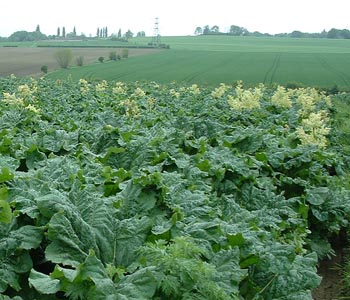
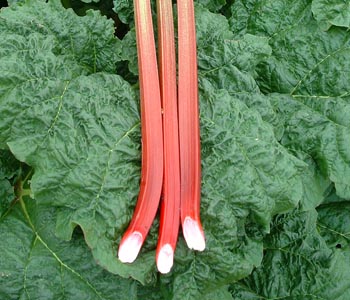
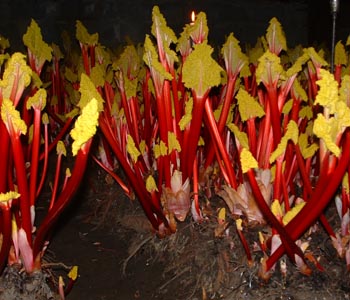
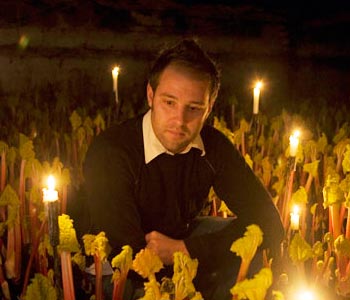
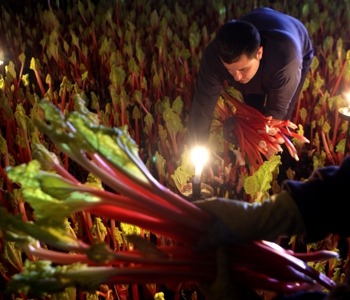
To produce a winter crop of rhubarb at home it is preferable to use a 2-year-old plant that has been well fed and has not had outdoor rhubarb taken from the plant in these preparation years. I would recommend using Timperley Early, as this grows more quickly than other varieties, which would not give you the early advantage.
Clean any debris away from the crown or surface of the root in late January early February, the plant should have received enough cold by then. Now unless you have an old coal shed that you could heat, then all you can do is protect the plant from the outside weather. I once watched a celebrity gardener who came here to film, advising loosely packing a chimney pot with straw, and I am sure most gardeners do it this way, but I can see a potential Botrytis problem here, also the sticks will be scratched, and have a slight taste of mould, as straw does harbour fungal spores.
The petioles do require air, and for ease of harvest, I think, use a chimney pot,- up which the petioles can grow, then pack with straw around the outside of the pot, cover the whole with a dustbin, and wrap with bubble wrap, leave for about 4 weeks before uncovering for the first time. If the soil is drying out, you can water around the
perimeter of the bin, but take care not to over water as this will induce botrytis. Harvest quickly and more will re-grow until weather conditions allow rhubarb to grow outdoors readily. Uncover the protected root completely and feed well, leave the plant to regenerate for at least one summer without harvesting.
You will require a number of roots and rotate their use, occasionally leaving un-harvested. In this manner, your roots will last for a number of years (Let me know if you have a better method to pass on). Better still, save yourself all the work and buy the best from us by mail order, or check out our name on the bags in your local supermarket.
By covering a root with a pot in your garden, technically you are not forcing but blanching. When forcing, the root has to be removed from its outdoor location heated and made to grow using the plants own energy reserves, so it must be out of the soil.
I have seen only one man do it correctly, and he filled an old outhouse with roots, although he did not heat to the temperatures that a commercial grower would.
Yorkshire Indoor Grown Forced Rhubarb…
…The History.
…The History.
ANCIENT HISTORY
The earliest recorded use of rhubarb is 2700BC, although its use is thought to date back much further. At this time rhubarbs use was as a very important drug of the time, being used for a variety of ailments particularly gut, lung and liver problems.
Marco Polo is attributed in bringing the drug to Europe in the thirteenth century when it was referred to as the Rhacoma root.
The drug was so highly regarded and much sought after that in 1657 in England it could command three times the price of Opium.
The first time the plant was seen growing in Britain was in the sixteenth century when the seeds were introduced in an attempt to grow and process the drug here, but the wrong strain was imported and eventually, its use in this country went into decline as the British version simply did not work. The rise of modern medicine eventually took over from the wondrous drug.
RHUBARB IN THE DIET
Rhubarb was first used in English cooking in the late eighteenth century probably in an attempt to get the benefits of the drug into the body (although it had been used extensively in Syria and Persia since the thirteenth century) only gaining in favour with the British when the forcing process was discovered in Chelsea Physic Gardens in 1817, when some roots were accidentally covered with soil in the depth of winter. On removing the soil some weeks later tender shoots were noticed. These were found to have a superior flavour and quality than anything ever seen before. From this initial discovery of blanching rhubarb, commercial growers in the London area began growing or blanching rhubarb, covering with soil or manure, some taking it a stage further, actually lifting the roots and placing in buildings to grow on. Rhubarb at last found favour with the British.
RHUBARB IN YORKSHIRE
In 1877 the forcing of rhubarb began in Yorkshire. The Whitwell family of Leeds are generally regarded as being the first large-scale grower to cause significant damage to the London growers.
It was the first place in the world that special sheds were erected just for the purpose of growing rhubarb out of season; the early basic technique was further developed and made their own by the Yorkshire growers.
The soil in the area proved perfect for the growth of the substantial root systems necessary to produced sufficient yields of high-quality sticks worthy of a premium price capable of covering the high production costs associated with this crop.
As rhubarb’s popularity increased so did the producers in this area, numbering at rhubarb’s height in popularity well over 200.
The quality of the Yorkshire crop became renowned, and demand for it became so huge that eventually producers in other areas of Britain simply could not compete, and eventually stopped altogether.
The producers were centralised between Leeds, Wakefield and Bradford, which became known worldwide as The Rhubarb Triangle, the centre for the world’s production of forced rhubarb.
Rhubarb, a native of Siberia was originally found growing on the banks of the river Volga.
This tells us two important things about the plant’s requirements.
1. Cold
2. Water
The third import requirement is Nitrogen.
The Rhubarb Triangle, situated in the shadows of the Pennines, is in fact in a frost pocket.
The Pennines have proved invaluable to the growers, as they also give us the high rainfall necessary to the plant. The Pennines also gave rise to the woollen industry in the area. As sheep grazed on its bleak hills they provided the wool for this other important Yorkshire industry. The Yorkshire water provided the power to work the massive looms.
(Yorkshire water some say helps to give the rhubarb its preferred flavour, as in the forcing sheds they are watered using only mains water.)
Almost as if following some great master plan the woollen industry gave the rhubarb industry the third important plant requirement, SHODDY, a waste by-product to them, but to the rhubarb industry, high nitrogen feed, cheap and readily available. The beauty of the nitrogen it supplies is that it is released slowly over a three year period as the fibres break down.
The massive Yorkshire coalfields provided a cheap local source of fuel to heat the sheds.
Geographically centrally positioned in Great Britain, coincidentally where railroads crossed, gave the producers a transport system to any corner of the country so that the days’ harvest could be in the market the next morning. Special trains left the area nightly, mostly bound for the old Covent Garden market, and from there large amounts were sold on into Europe.
The trains became known as the Rhubarb Express trains as they rushed to get their valuable cargo to market, carriage after carriage containing the only rhubarb.
During the Second World War, the government controlled the price of Yorkshire forced rhubarb at one shilling per pound to keep it financially within the means of the ordinary people.
Rhubarb became part of the staple diet of wartime Britain, and Yorkshire forced rhubarb became almost a national institution.
The industry became one of the largest providers of employment for the area, as production year on year increased.
Family secrets of production and each families individual much-prized strains were handed down from generation to generation. Family names such
as Cartlidge, Wade, Asquith, Smith, Dobson, and Oldroyd became synonymous with Yorkshire rhubarb, and growers “fought” to gain the much prized awards for their own particular strains at the annual rhubarb show.
The ‘Crumbling’ of an empire
Unfortunately when you are at the top the only way is down, as with any over exposed celebrity. War time Britain’s palate was rather on the sweet side, and they simply could not get the sugar that they required to bring this sharp flavoured vegetable to their taste. Eating large amounts of an item that many found
too sharp did rhubarb no favours. However well meaning were the parents who made children, ‘eat up your rhubarb its good for you’ helped to turn a generation away from rhubarb as they were nearly force fed the stuff.
Although they probably did not know why, rhubarb was good for them, it actually helped along with the rest of their diet, to keep them very healthy.
Sticks of rhubarb and a bag of sugar given to children to substitute their sweet ration, now bring back fond childhood memories to many.
Lumpy custard and stodgy green rhubarb crumble for school dinner won rhubarb no friends.
After the war, suddenly as overseas trade began and quick easy refrigerated logistics made a wide range of new tropical fruits readily available. Poor old rhubarb was left on the shelf (or in this case the garden).
This spelt disaster for the rhubarb triangle, as the producers were massively over producing resulting in a loss on their production costs, some went bankrupt, others sold up before they did, others turned to other crops Year on year growers left the industry
Being part of the heritage of the Wakefield / Leeds area, and having current public interest in its production techniques visitor’s flock to the Wakefield annual rhubarb festival as the humble rhubarb sheds have now become a tourist attraction.
Perhaps not so humble when the likes of Rick Stein, Nigella Lawson, Anthony Worrell Thompson, Jamie Oliver, Phil Vickery, James Martin, Brian Turner and Hugh Fernley Whittingstall, all sing the praises of Yorkshire Forced Rhubarb.
Indeed, Traditionally Grown Yorkshire Indoor Rhubarb is to the rhubarb industry what champagne is to the wine industry.
Not to be mistaken with an actual variety of outdoor rhubarb called Champagne, as some journalists and celebrity Chefs refer to forced rhubarb as ‘Champagne rhubarb’ due to its preferred flavour.
Yorkshire Rhubarb Varieties
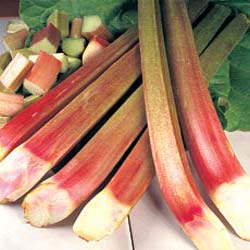
TIMPERLEY
EARLY
One of the earliest commercial varieties, very popular, having a good flavour. Widely grown for early production, with a good colour, but will grow green in warm temperatures if you let it Early-Mid April start to harvest outdoors. First early forcing variety. Medium yields.

STOCKBRIDGE HARBINGER
Closely follows the above variety. Erect stick with good early colour but soon goes green outdoors. Excellent blood red colour when forced. Excellent flavour, but its exacting growth and harvesting requirements, result in this variety not been widely grown commercially. Best left to the experts, or if you like a challenge, then given care in a forcing shed in my opinion nothing to match it early season. Modern variety. Medium yields.

REEDS EARLY SUPERB
Regarded as being the same as Fenton’s Special. (Growers often claimed new varieties, when in fact they were simply variations of a particular type.) Follows Harbinger. Up until the development of Harb. Reeds was the first early variety with deep colour when forced. Easily distinguished by its slightly earthy flavour when forced Retains its colour better than most early outdoor varieties.

STOCKBRIDGE ARROW
Main crop variety. Early to mid-May first harvest. Outstanding modern variety, excellent flavour and colour. Holds its colour longer outdoors than most. Excellent quality of stick. High yields. Easily recognised in a forcing shed by its arrowhead-shaped leaf and blood red stick. We regard this variety as THE most important new variety of quality and yield. An excellent all-around performer, a must for every garden, still to be beaten.

QUEEN VICTORIA
Main crop to late, first harvest mid to late May. Excellent flavour, strong bold sticks. Very heavy yields. Older variety still retained for use due to flavour and exceptional yields. Excellent for forcing although in the garden situation an early variety is preferable for blanching
This variety is a favourite in Scotland, or by people who like to make their own jams, due to the flavour it gives. Not suitable for growing in tubs as it forms a large root. I am often asked if rhubarb can be grown in a tub by householders who only have patio areas. The answer is yes if you must, but will you remember to water it sufficiently enough, especially in high temperatures, and it must be a big tub to accommodate the root as it grows. It will require splitting regularly every couple of years once established, and you must understand your plant’s needs.

CAWOOD DELIGHT
Autumn 2006 Outstanding colour, deep red stick, even upon reaching its full growth potential, even extending up into the fleshy ‘veins ‘ of the leaf. Colour ‘bleeds’ into the flesh and quickly colours it red, so the deep colour of forced rhubarb is obtained with an outdoor grown stick, which makes it excellent for cooking.
The higher fibre levels in the stick help it hold together better when cooked. Very good flavour. Not suitable for forcing. An outstanding late variety harvesting from late May, but its low yields do not make it suitable for commercial growers. Much sought after by gardeners although rarely obtainable to purchase. Unfortunately, all good things have a drawback, – it’s the most difficult to grow, so not for the beginner. It propagates only very slowly, which makes it a little more expensive than the rest. Due to the hot summer 3 years ago we protected our stocks of this superb variety, and it will be obtainable for mail order again in Autumn 2006
Commercial Yorkshire Rhubarb Production
‘It is better not to do a job at all if you cannot do it to the very best of your ability’
To ensure the maintenance of the high-quality produce to which our company has become associated, we insist that the following rules are observed.
All roots have a specific purpose
Forcing or indoor harvest: We use 2-3 year old roots from which an outdoor crop has never been taken, thereby ensuring that a maximum energy store is laid down in the root, and not used by the plant for petiole production. This energy store will be used by the plant for growth once in the forcing sheds. Unfortunately, the forcing process results in the death of the plant. These must be constantly replaced each year to ensure an adequate supply of forcing roots year on year.
Outdoor crop production
We only harvest for 3 years from a particular batch of roots, (crop quality and yield is impaired after continual harvesting) then we destroy the roots by rotovating into the land, which in itself acts as an organic feed for the following crop in that piece of land (usually brassica, or wheat).
Main stock reserves
It is from these roots that we propagate our strains forward, to ensure their survival. It is therefore imperative that only the very best roots are used for this purpose. An outdoor crop is therefore never taken.
Accumulated cold units
The roots must not be lifted from the ground and taken into the forcing shed until they have received the necessary amount of frost specific to each variety. It is this frost that converts the root energy store into a form accessible to the plant for growth when it is taken into the sheds and does not have access to food or light.
Harvesting forced rhubarb
Although very time consuming it is essential that the whole of the petiole is removed intact from the root. This necessitates that a finger is inserted between the stick and the bud, and gently pushed to the base of the bud before simultaneously twisting and pulling. Any remnants of the stick base would rot, causing a botrytis problem, so again gently does it.
Organic Feeds
All land allocated for rhubarb production is prepared prior to planting using a mix of farmyard manure and shoddy, as indeed throughout the Rhubarb Triangle it historically has, for nearly 200 years, only today, the land and feed is tested for nitrate and mineral contents, and applied accordingly We are sure that the use of organic feeds helps to give the product a better flavour and quality. Rhubarb is a high Nitrogen feeder and requires certain specific minerals. Certainly without which we could never get sufficient energy into the roots for forcing. Unfortunately, many gardeners abuse their roots and think they do well enough without. How much they are missing!
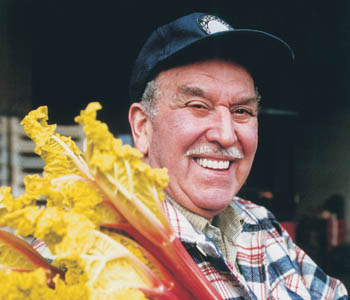
I will always remember something my father always said to us in regards to his land, ‘You only get out as much as you put in’.
I think that this is a good philosophy to life as well!
I will always remember something my father always said to us in regards to his land, ‘You only get out as much as you put in’.
I think that this is a good philosophy to life as well!
Yorkshire Rhubarb Culture Notes.
Ideally, your set, (root) should be planted as soon as possible. If not planting immediately, remove your sets from their plastic bags, wrap in newspaper and store in a dry shed for up to 2 weeks only. If mould has appeared on the cut edge whilst in storage, gently brush off and rub with a hormone rooting powder which contains anti-fungicide.
Planting site
Select a well-drained area that has not cropped rhubarb in the last 6 years. Not too close to hedging and not waterlogged soil.
Preparation
Preferably compost or manure should be well dug in 4 weeks prior to planting. Compost should be well rotted or it will destroy your root. If in doubt don’t use and apply around the perimeter of the root / not directly on top in year 2.
Planting
Your set should be planted crown (top of the set where the buds are) uppermost into well-dug earth so that the crown is approx 2 inches (5cm) below the soil surface. As the plant establishes itself make sure that the growing plant does not protrude too far through the soil surface. Do not apply organic muck directly against your set. Do not be tempted to harvest any sticks from the root in its first year, thus allowing root establishment. To do so would seriously weaken the root, particular Cawood Delight. Simply allow the sticks of rhubarb to rot back in the autumn.
Aftercare
Apply a multi-compound feed such as ‘Grow More’ in Spring( year 1) to help aid root establishment.
Top dress with a high nitrogen feed such as Nitro-Chalk, Hoof and Horn or Dried Blood each spring (year 2 onwards) to increase yield. Spread organic compost around the perimeter of the root surface during dormancy if you produce organically.
Weed Control
A light covering of mulch or chopped bark around the surrounding area will help control weeds and help retain moisture. Chopped rhubarb leaf around the perimeter will help prevent weed growth.